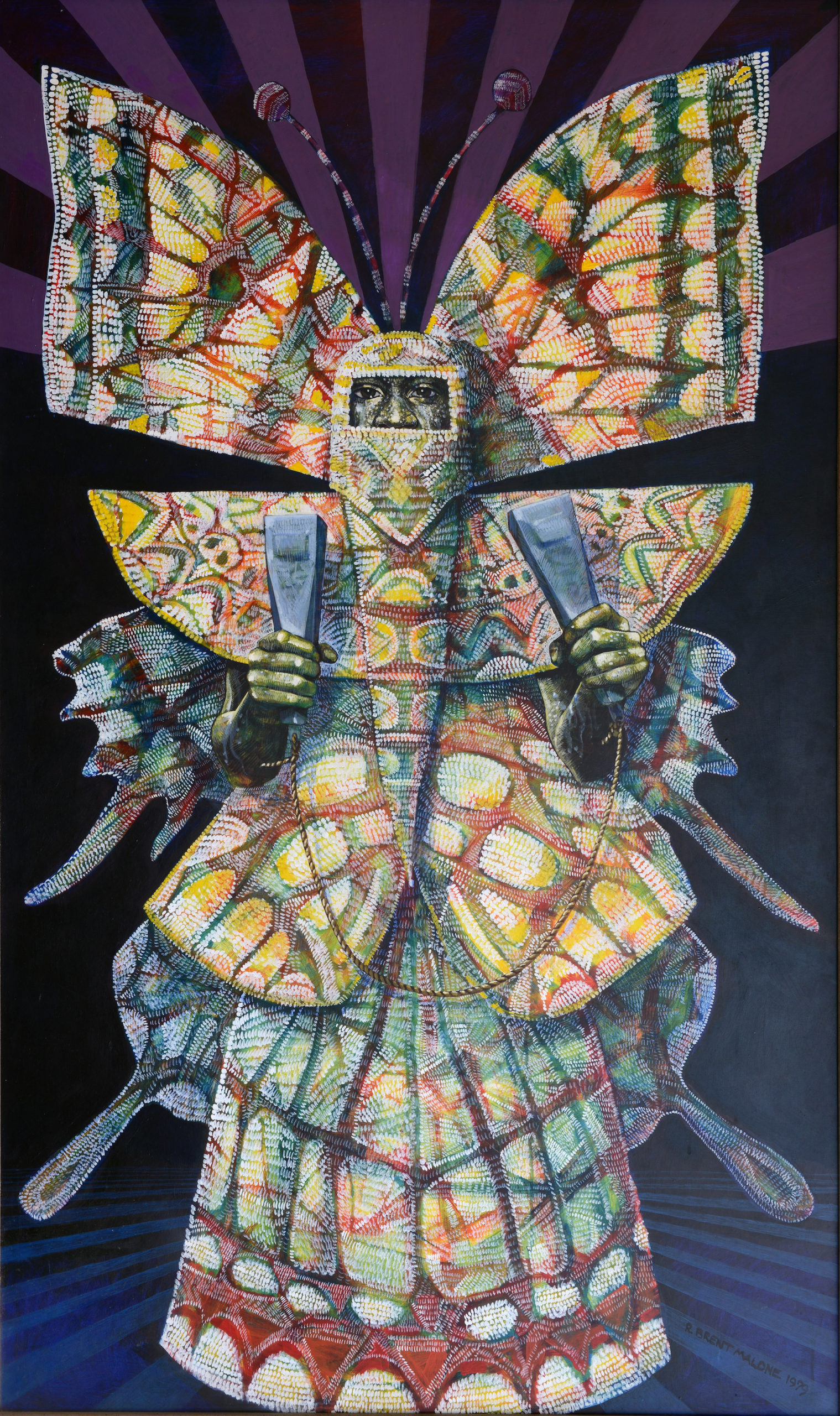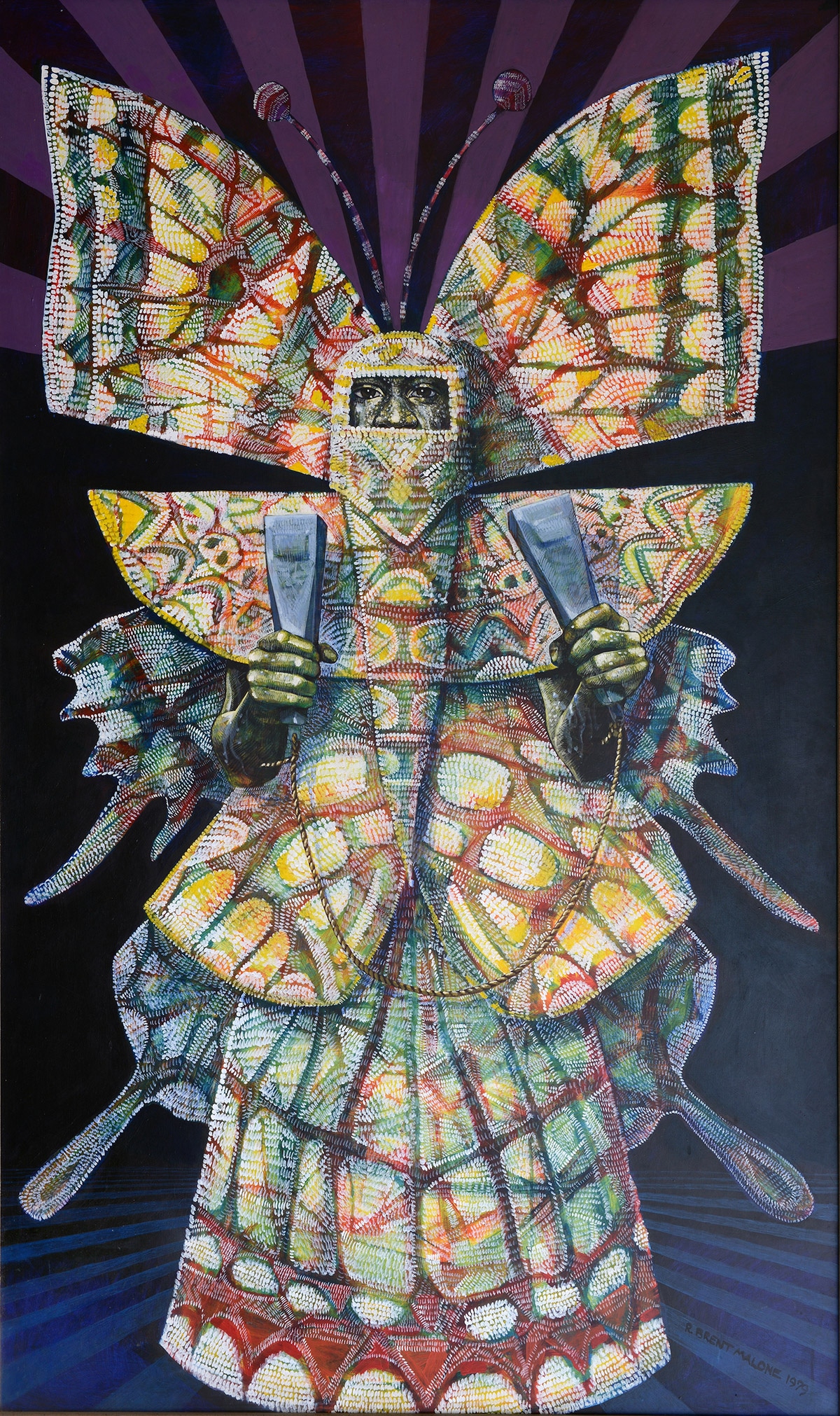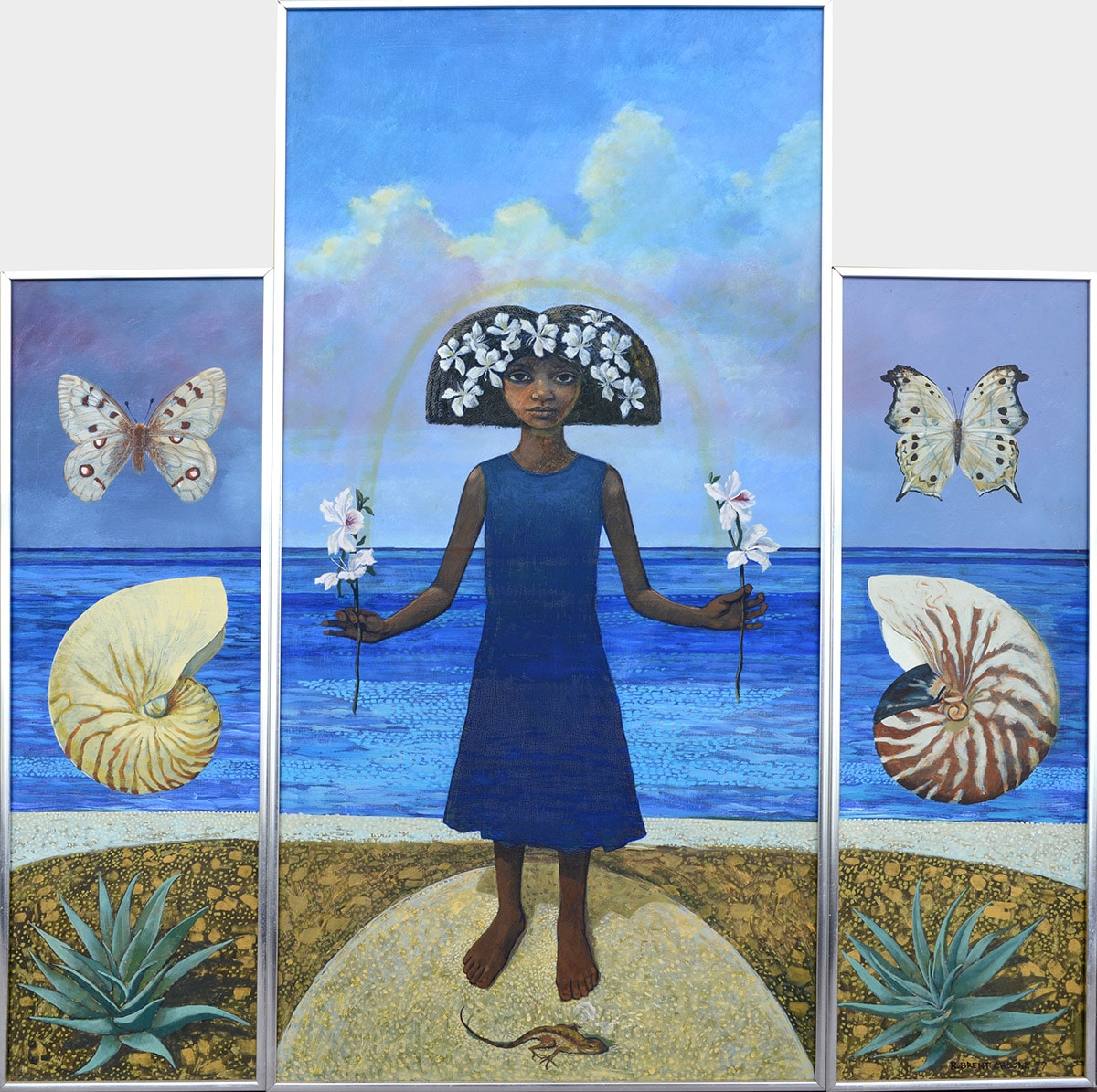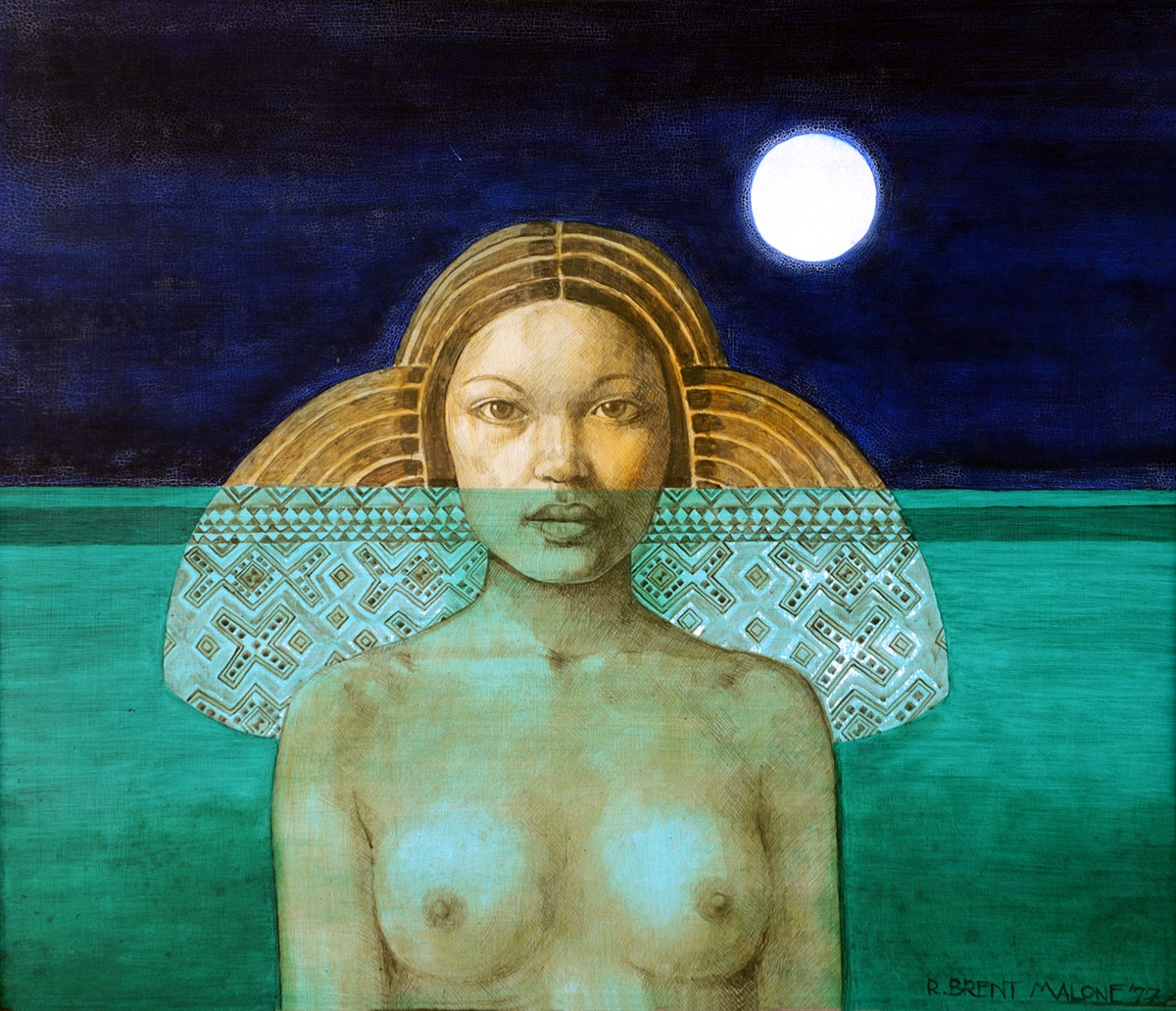From the Collection: “Metamorphosis” (1979) by R Brent Malone

By Natalie Willis.
There are few artists who were able to evoke the energy of Junkanoo as Brent Malone did. He didn’t just show vibrant costumes swaying lightly: he showed colours and costumes that vibrated, bodies tense with energy and muscles coiled as cowbells get poised to strike, eyes as red as the feathers from that 3 am lap, sweat dripping down faces holding tired red eyes. Malone set out the path for others to display Junkanoo as the manic, feverish, exhausting, and mesmerizing spectacle it is – he made it his mission to show the feeling at the root of the celebration, the cathartic outpour of energy and freedom. It is fitting that he lends this deference of accurate portrayal to a work that means so much to so many: “Metamorphosis” (1979) is a testament to the idea of a nascent Bahamas, the burgeoning forth of a still transforming nation after independence.
Malone was a Bahamian of European descent who came of age in a segregated, colonial Bahamas. All the more touching then, that he set out so adamantly to claim his sense of Bahamian identity while being so proud of his Britishness – as in many ways Bahamian culture is Black culture, and Malone inserted himself into spaces with the Black majority and celebrated the triumph and history of Bahamian people in all it’s facets. In fact, he had said himself in conversation with Fred Mitchell writing for the Nassau Guardian in 1982: “I feel the rush of Junkanoo music as much as you do… I’ve never felt like an outsider here because I am white. I’ve hardly been conscious of the difference, in fact I can’t afford to, because I feel very strongly identified as a Bahamian and I see The Bahamas as so much a Black experience”

“Metamorphosis” (1979), R Brent Malone, acrylic on hardboard, 60 x 36. Part of the National Collection, purchased using the Membership Fund 2005-2006, currently on display in the NAGB’s Permanent Exhibition “Revisiting An Eye For the Tropics”.
“Metamorphosis” (1979) doesn’t just speak to the transformation and to the birth of a nation, as the title suggests, but it also alludes to a rebirth of the artist as someone claiming his identity and inserting himself into the narrative of Bahamianness outside of white Britishness. The butterfly costume with its shaking white fringe dazzles you, it shakes, just as the newly born butterfly shakes itself dry and the cowbeller rhythmically shakes the bell to add a steady undertone of sound to the music of Junkanoo. The choice of a beller in particular is a way to pay homage to the everyday roots of Junkanoo.
The piece also tells of a period in Malone’s career where he wasn’t just being a student, this Bahamian surrealist period of his works – notably seen in pieces such as “Earth Sea Sky (Triptych of Unity)” (1977) – is also arguably the only time in his lengthy career where he developed a style that was purely and palpably his own.
You cannot learn how to be free, you have to take hold of it yourself, you have to forge your own way forward not knowing what it means but knowing what you need. This uncertainty also adds to the tension of the image, with the million tiny white strokes, because there is a tentativeness and potential energy of just that, of potential, of the unknown.

“Earth Sea Sky (Triptych of Unity)” 1977, R Brent Malone, acrylic and oil on hardboard, 17 x 8 ½ (2), 36 x 17 ½. Part of the Pam Burnside Collection.
Further, these works were being made at the same time as Bahamians were claiming not only their independence, but that African-descent Bahamians were claiming their Blackness – albeit via an adoption of American Blackness of the 1970’s. There was a distinct turn away from the hundreds year old British propriety, and toward a shameless celebration of identity. It was a Junkanoo of identity as much as Junkanoo itself was a celebration of freedom and self back when slaves were parading through the streets of old colonial Bahamas on their 2 days off a year.
And these works gain meaning and understanding with the 20/20 vision of hindsight and retrospect, and as it was acquired in 2006 from the membership fund of the Gallery there is more of a poignant evocation put forth. Malone had dreamed of and fought for the legitimacy and importance of the idea of a National Collection and a National Art Gallery, and we later chose this piece for its representation of Independence. There is a heartwarming cyclical quality to the life of this work, from its inception at independence to its acceptance into the cause Malone championed for years. The life of this piece is reflective of Malone, and shows the forward-thinking and hopefulness of the time.

“Lucayan Princess” (1977), R Brent Malone, oil on canvas, 24 x 27. Part of the D’Aguilar Art Foundation (formerly in the collection of June Knight).
Stuart Hall, the late and much beloved Jamaican cultural theorist once said of the Caribbean that we are not the people who go forth and ‘build the modern’, that we are the ‘conscripts of modernity’ – the ones who do not shape it, but arrive at it nevertheless. I would argue that now, in the wake of this particularly heart wrenching and destructive hurricane season that has seen us lose the cultural material almost completely on two islands–with severe losses of cultural material and buildings on others–that we may not have been the architects of modernity, but we can certainly be the creators of the contemporary Bahamas.
We are an independent Caribbean nation (problems of neo-colonialism aside), and as we look for ways in which we can take this tremendous loss in the Southern Bahamas as a fuel to help us rebuild a new and more sustainable Bahamas (particularly with Ragged Island set to be a completely remodeled ‘green’ island after their devastation) – it is a way for us to look to this artwork once more as a beacon of the hopefulnessas we see our people putting dreams,change and their lives into action. It is our time to shake out of the comfort of our chrysalis, enjoying the dreams and ideas of change, and to emerge as a formed and capable island nation being reformed. We are a country changed, a region changed, and moving forward we see little help from those outside of ourselves and our Caribbean brothers and sisters and diaspora – but together we can put our motto to good use and refuse to allow the despair and defeat sink in: “Forward, Upward, Onward, Together”.